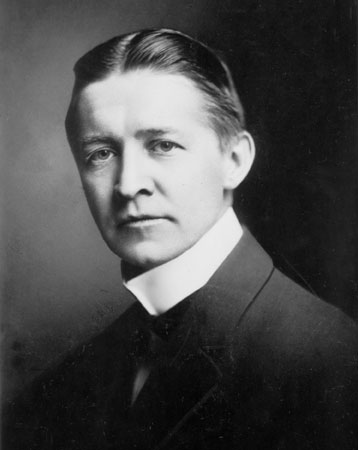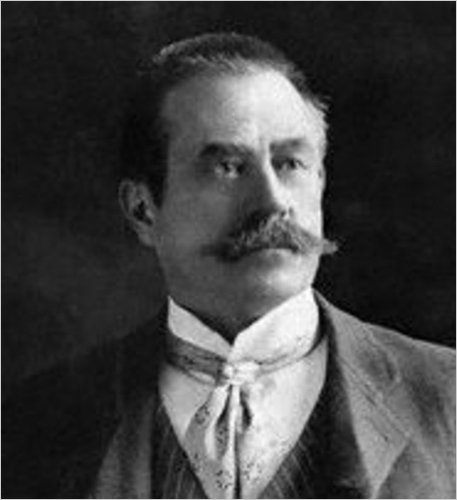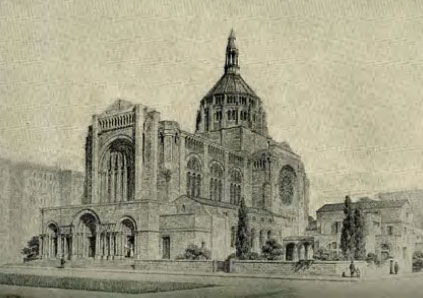Original Proposal for St. Bartholomew's Church, 1916
Bertram Grosvenor Goodhue

Bertram Grosvenor Goodhue, one of America’s foremost architects widely known for his ecclesiastical structures, was commissioned in 1914 to design the third site of St. Bartholomew’s Church on Park Avenue. Prior to St. Bartholomew’s, Goodhue’s forte was the Gothic Revival, a style he reinterpreted in a modern manner, particularly in the design of one of his major works, the Church of the Intercession in New York (1912-1915).
Goodhue was born in 1869 in Pomfret, Connecticut. He was educated at home and was fortunate to have a neighbor who was an artist who taught him how to draw. Drawing was one of his most important talents when he reached his teens. Goodhue’s architectural career began in 1884 in New York City at the age of fifteen as an apprentice of James Renwick, the architect of such Gothic monuments as Grace Church and St. Patrick’s Cathedral. Goodhue quickly revealed his talents in the Renwick office, moving up from office boy to the important post of “delineator,” a key position in a nineteenth century architectural firm.
While in Renwick’s office, Goodhue also exhibited his extraordinary artistic abilities by designing a complete typeface, “Cheltenham”, still widely used. He was soon designing entire books, such as an exquisite edition of Elizabeth Barrett Browning’s Sonnets from the Portuguese.
Upon his affiliation in 1891 with Cram and Wentworth, Goodhue refined his use of the Gothic form, bringing its design elements into the 20th Century with recognizable modern iconography. In 1914, Goodhue established his own firm, wishing to expand his creativity beyond the confines of the Gothic. Goodhue refined classical architectural form with an eye toward a simpler more contemporary American architectural style.
Stanford White

Stanford White (1853-1908) of the preeminent architectural firm McKim, Mead & White designed the Triple Portal in 1903 for St. Bartholomew’s Church at its previous location on Madison Avenue. Modeled after the portal of the Benedictine Abbey of Saint-Gilles-du-Gard, this would be the final flourishing of White’s love affair with the Romanesque architecture of southern France. He first saw the style in the innumerable photographs that his first employer, H. H. Richardson, had in his office and studios in Brookline, Massachusetts.
The Romanesque was a primary source of inspiration for Richardson, whose work launched the “Richardson Romanesque” style in America. White had been the architect in charge of Richardson’s Trinity Church in Boston in the 1870’s, a masterpiece of Romanesque Revival.
He would have a chance to see the real thing in July 1878 when he went on a pilgrimage to Provence with architect Charles McKim and sculptor Augustus St. Gaudens. While traveling, he came across the Abbey Church of St. Gilles-du-Gard (ca. 1170), one of the earliest Romanesque examples of the grouping of three doorways into a single composition.
In a letter to his parents from Paris, White wrote about St. Gilles with “the best piece of architecture in France, the triple marble porch of the church.” A quarter of a century later, he would design the new entrance for St. Bartholomew’s Church with the much-admired portico of the Church of St. Gilles-du-Gard as inspiration.
Bertram Goodhue Associates - Mayers, Murray, and Phillip
Mayers, Murray & Phillip was the sucessor firm to Bertram Grosvenor Goodhue, the prominent New York City architect. In the spring of 1924, after a trip to Los Angeles where he was involved in building the public library, Goodhue succumbed to a heart attack, just days before his fifty-fifth birthday. After Goodhue's sudden death, his office was reorganized as Bertram Grosvenor Goodhue Associates to complete outstanding commissions. This included the St. Bartholomew's Community House and the Great Dome. In 1931, the firm was renamed by its principal partners, Francis L.S. Mayers, Oscar Harold Murray, and Hardie Phillip. The firm closed in 1940.


